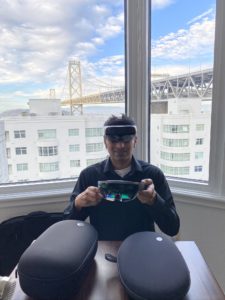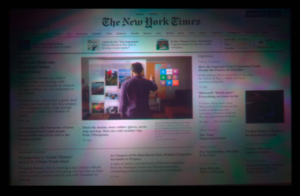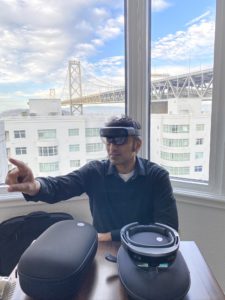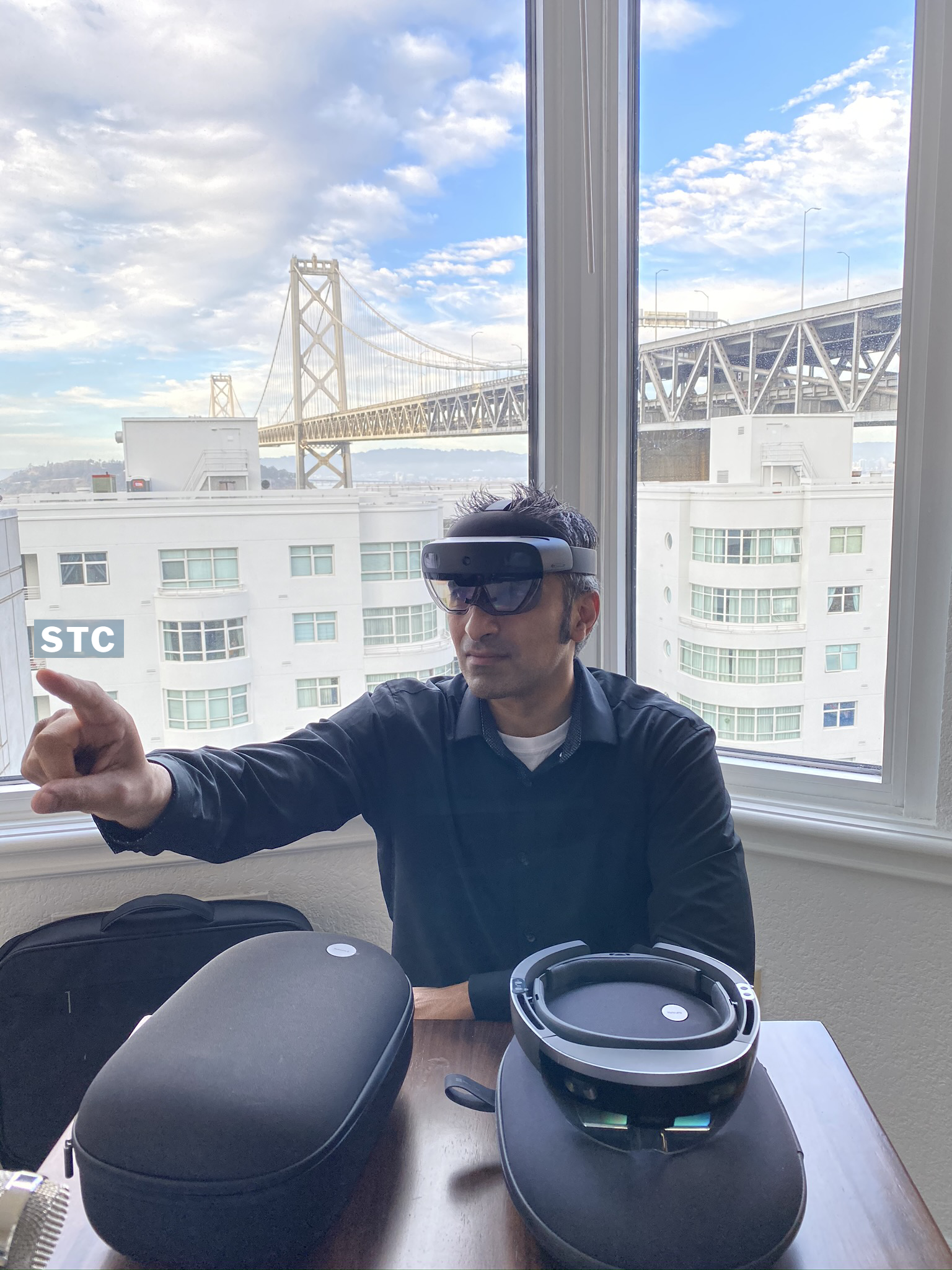
In this short post, I’m going to compare my experience with both Microsoft Hololens 1 and Hololens 2 and provide some valuable insight.
Hololens is Microsoft’s augmented reality headset. Unlike virtual reality, where the headset prevents you from seeing the actual world around you and completely immerses you into a virtual world, augmented reality instead overlays digital objects or holograms over the real physical world. The popular Oculus and HTC headsets are examples of virtual reality headsets. Microsoft Hololens and Magic Leap are examples of Augmented Reality headsets. Check back on this site for my 101 on Virtual Reality, Augmented Reality, and everything in-between which I plan to post shortly.
Below, to keep blog a reasonable length, I don’t cover all the specifics, but call out some of the major differences from my experience working with both of these devices.
- Pricing
As briefly mentioned earlier, Hololens 2, to buy straight-out is $3500. I was hoping the second generation would fall in price from, the 1st generation Hololens 1 which was set at $3000, but unfortunately price actually went northward by $500 more. Both headsets are still amazing and I would say the most advanced and business-savvy Augmented Reality headsets out there. Magic Leap is also very impressive, but from a business perspective, Hololens running the Windows Holographic for Business OS and respective ecosystem with Microsoft Store, One Drive, etc. seems way ahead.
- Hololens Physical Exterior
With the Hololens 1 and Hololens 2, physically, they look almost identical from the front. Most folks probably wouldn’t be able to tell the difference without looking closely. Before continuing to read, take a look at the picture above in this post. Can you tell which one is Hololens 1 and which one is Hololens 2?
One big change with the Hololens 2 is that the CPU and computer components are moved to the back of the headset. If you look at the Hololens 1, these components actually sit near the front of the headset. Moving the components to the back actually helps with the comfort as the headset is not as heavy feeling and not pushing down onto your nose; because of the change in placement of these parts, the Hololens 2 actually feels more balanced when wearing it.
The other main difference I noticed right away was the thicker, more sturdy additional strap coming over the center-front of the headset to the back. This again is an additional improvement as I found it provided more support to hold the headset in place comfortably. You can see this in the picture above; this is the most obvious give away, in my opinion. The Hololens 1 had a thin plastic strap that could optionally be used and ran side to side across the headset providing additional support (not shown in the picture).
The other nice improvement I really like in Hololens 2 is the ability to flip up the visor. Although, the real world view is transparent and unobstructed with augmented reality headsets unlike virtual reality headsets, this flip-up visor makes things easy when you just need to grab a bite to eat or need a drink.
Finally, the Hololens 2 at 566 grams does manage to come in slightly under the weight of Hololens 1 at 579 grams.
- CPU and HPU
Both of the headsets have a custom-built holographic processing unit (HPU) which contains a number of cores and helps to recognize gestures, map and remember environments, and position Holograms in the 3D world. The Hololens 2 is on the second generation of the HPU.
For CPU, Microsoft pretty much ditched the Intel 32-bit architecture used in Hololens 1 for the more power efficient and thermal management capabilities of Qualcomm Snapdragon 850 Compute Platform used in Hololens 2. Hololens 1 would automatically shut down upon overheating; I have not seen that behavior yet with Hololens 2. However, even with Hololens 2, I did see in one occasion, a warning that headset was overheating and I should give it a rest; I stopped using it for 10 minutes to allow it to cool down and haven’t seen the warning since.
- Memory
Memory has improved from 2 GB in Hololens 1 to 4 GB in Hololens 2.
- Hololens Optics and Resolution
Both Hololens 1 and 2 have see-through holographic lenses, but Hololens 1 only has HD 16:9 light engines (1280 × 720) in each eye while Hololens 2 has 2k 3:2 light engines (2048 × 1080) in each eye.
- Field of View (FOV)
The biggest and most long awaited improvement is the FOV. Hololens 1 had a FOV of ~34 degrees (equivalent in size of about an index card floating 1 1/2 feet in front of you). Hololens 2 has improved upon the FOV to around ~52 degrees. This means, you can actually see more of what’s around you and the holograms can consume more of the available view without being cutoff.
- Visual Quality
Although I love Hololens 2, the main disappointment for me is that, although the FOV is better than Hololens 1, the overall visual quality/clarity, even with the better optic specs, is less impressive than Hololens 1. It was bad enough to the point where I actually thought I may have a defective unit and had to open a support case with Microsoft only to be told the behavior is expected due to the change in display technology from what was used in the Hololens 1 and due to trade-offs with brightness, color, and FOV.
The issue is the worst with white backgrounds (for example a web browser with webpage with typical white background). It is true, browsing the Internet likely isn’t the primary use case for Hololens. However, issues are still there even with other apps just doing overlay on real world; it’s just not as extreme or obvious.
Doing a quick search on the Internet, I realized the rainbow-type effect, color bleeding, and distortion was something being brought up by many folks using Hololens 2, so it wasn’t just me or my specific device.
Below is an image of what Microsoft support provided me on what I should see when viewing a webpage. Again, this is not from me, but the example Microsoft provided me which does align with the issues I communicated to them in the support ticket. What, I actually see, I would say probably is not as bad as this – at least from my use with specific sites. In any case, for a $3500 headset in second generation phase and targeted for business use, I had higher expectations here. With that said, I’ve still tested to the max with Microsoft Edge and multitasking with several browsers up while running other applications and using my Bluetooth keyboard and mouse with pretty good success. It’s a nuisance, mostly on white backgrounds, but overall doesn’t block me.

- Eye Tracking
Eye tracking is introduced in Hololens 2, and provides for better accuracy and ability to determine what the user is looking at. This improves the overall eye-gaze based interactions. This feature is lacking in Hololens 1. The Hololens 2 adds two IR cameras to assist with eye tracking.
- Hand Tracking
I believe hand tracking capabilities in Hololens 2 is the second most noticeable improvement after the FOV. The improved hand tracking capabilities and additional gestures available like hand ray and select are really impressive. Although, still not perfect, the hand tracking is a vast improvement from Hololens 1. I did notice in several instances, in less light, the hand gestures do not pick up as easily, and, in some cases I would have to repeat the gesture more than one or two times for it to work.
The Hololens 1 has a Clicker that can be used for clicking and navigating. Hololens 2 completely does away with the Clicker, which makes sense due to the increased accuracy and capabilities of hand tracking and gestures.

- Camera – Pictures and Video
The picture and video capture capabilities with the camera also improve with Hololens 2. Hololens 1 has a 2 MP photo capture and HD 720p30 video capture while Hololens 2 supports a 8 MP photo capture and HD 1080p30 video capture.
- USB connectivity
Although not a terribly huge thing, I am not a fan of micro-USB and was glad to see the Hololens 2 no longer uses micro-USB and has instead switched to USB Type-C; this is the port used to connect to the computer and power supply for charging.
- Applications
Hololens 2 is still fairly new, and unfortunately cannot run the same apps developed for Hololens 1 (which there weren’t many to begin with), unless the specific app has been ported over to Hololens 2. Hololens 2, being fairly new, has even less apps than Hololens 1. Hololens is meant for business and there are some business apps and opportunities for businesses to develop for their specific needs. However, unlike Magic Leap, you can definitely see the focus has not been gaming or entertainment with Hololens – but as Microsoft has always said, the Hololens is for business and developers.
With that said there are a few interesting games and apps by Microsoft to showcase the capabilities of augmented reality with Hololens 2. Make sure to check out my later blogs and demo videos I will be uploading soon highlighting some of these and other development capabilities.
I should also mention it is also possible to deploy applications on Hololens 2 if they were developed using only the Universal Windows Platform (UWP) APIs. Windows 10 introduced UWP, which provides a common app platform on every device that runs Windows 10. The UWP APIs are consistent across all Windows devices ensuring compatibility. Although these apps will work on Hololens 2 or even Hololens 1, they will not be leveraging the Hololens capabilities and will run more like typical applications on a desktop PC/laptop.
I hope this blog post has been useful for you. Again, this is by no means a comprehensive list of all the capabilities and comparisons or things to know about Augmented Reality or Microsoft Hololens. I do feel I touched on the more drastic differences between Hololens 1 and Hololens 2 and important things to consider/know.
For more details/explanations and demo walk-through on augmented reality and Hololens 2, make sure to check out my next blog and short 5 min intro video posted on the SuperTechCamp YouTube channel. Until next time.
Follow Super Tech Camp on twitter.
